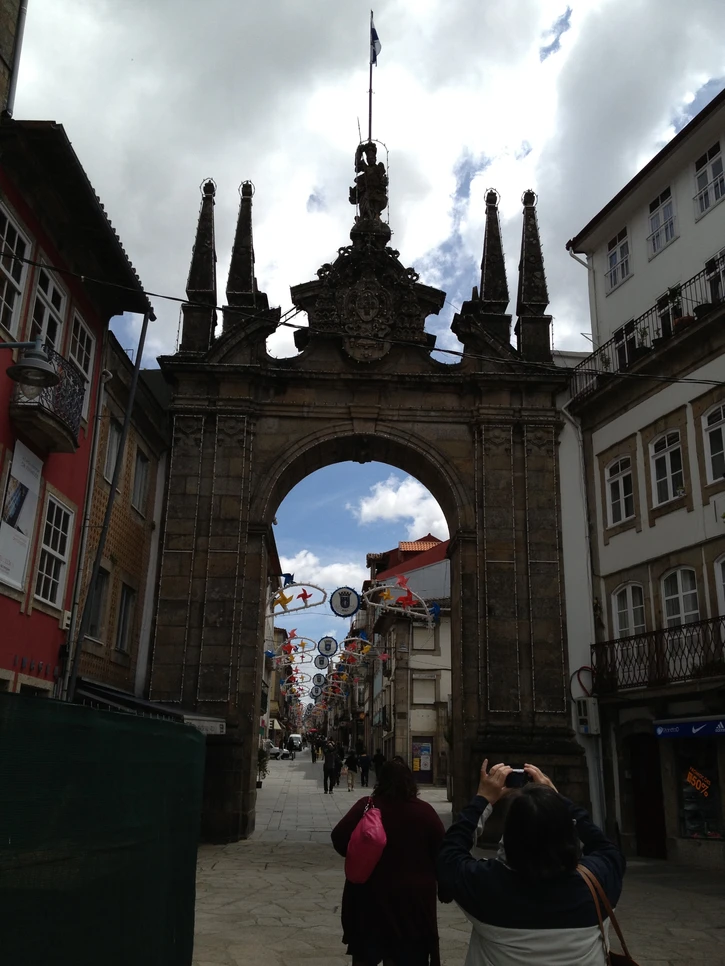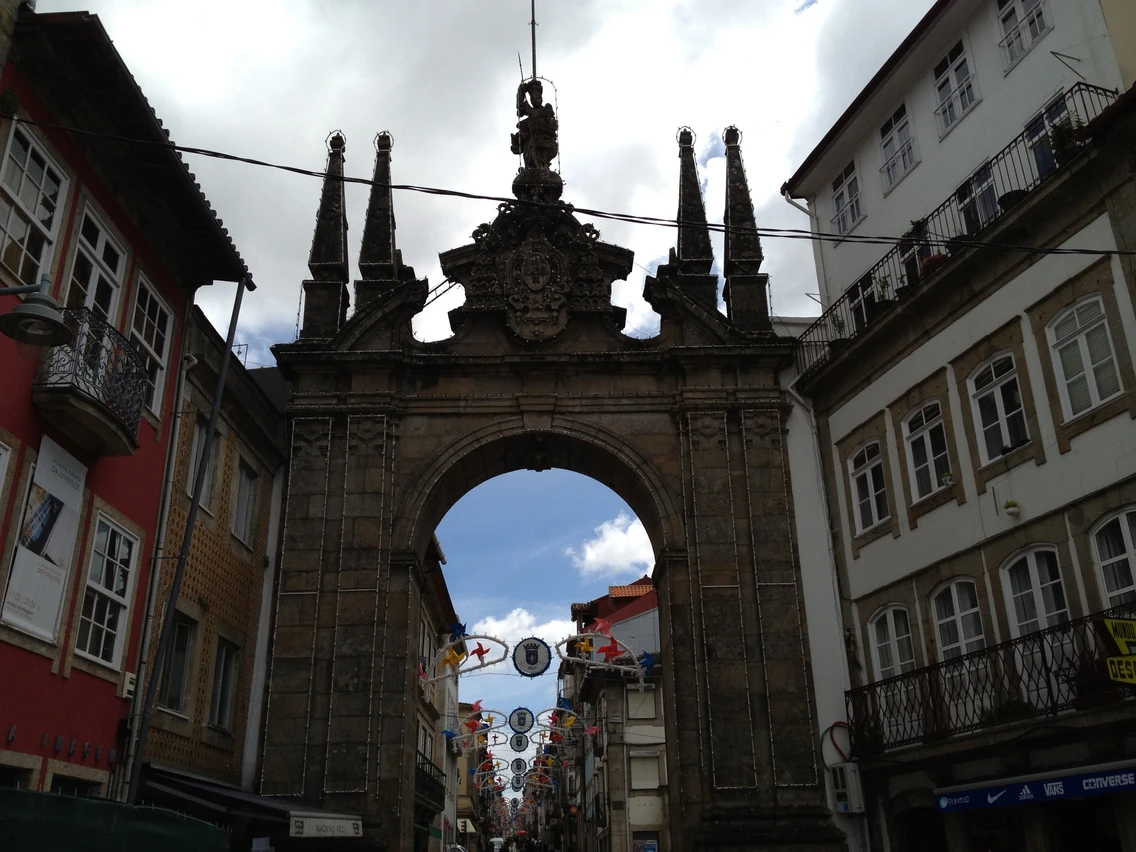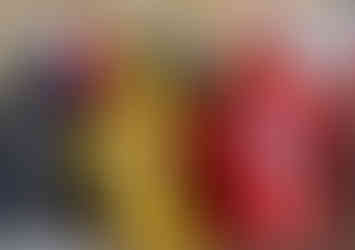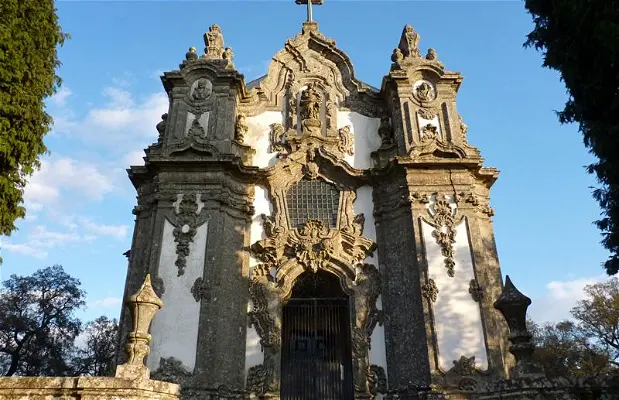Our bus descended down the hill and made its way to downtown Braga. We were to go there for lunch and a bit of sightseeing.
As we approached the city centre, our Travel Director mentioned that Braga was founded by a Celtic tribe and later became a Roman stronghold. It was made the administrative centre of Gallaecia (now encompassing Portuguese Minho and Spanish Galicia) and the country’s religious capital, as well as the headquarters of the Portuguese bishopric in the 11th century. Hence, it is a city rich in history and teeming with impressive Baroque churches, magnificent monuments, beautiful squares and gardens, splendid houses, and pedestrian streets.
We were dropped off by the Arco da Porta Nova, the gate to the city built in 1512. The gate, as well as the streets surrounding it, was festooned with colorful banners and paper flowers. Our Travel Director said that these were remnants of the June 24th fiesta – the feast of Sao Joao (Saint John), where the locals take to the streets to celebrate for days.
My travel amigas and I didn’t lose time searching for a nice sit-down restaurant that offered local fare. To save time, we asked some locals congregating outside a meat shop. They told us to go one block down, make a right, and walk past the first block. The restaurants there would be less busy, they said. The street we were on was filled with townsfolks and sightseers alike and we noticed that most of the food establishments around us were teeming with tourists. We figured most of our tour mates would be looking for places to eat along this street and that these would most probably be filled to the rafters...thus, would most probably offer slower service.
We followed the direction we were given and stumbled upon a much quieter alley lined with small, but elegant restaurants. We asked one of our amigas to pick a place at random. She chose the one with a terracotta façade, tall glass white-curtained windows topped by black awnings, and a simple white against red sign – Cozinha da Sé.
Inside, we were greeted by uniformed servers and led to a small table by the window. The interior was chic and modern with a touch of the traditional – bright red wall on one side, exposed brick wall on the other, brick arches, wooden pillars, hardwood flooring, wrought-iron decoration, eclectic chandeliers providing mood lighting, upholstered furniture, and modern paintings by local Braga artists. On one side was the bar with a huge collection of wine, mostly Portuguese. On one corner, under one of the arches, was a pile of straw baskets and wooden crates containing more wine bottles and pieces of pottery. The restaurant definitely made an impression on us. And better yet, it was not very busy. We were immediately served some freshly baked bread and butter squares.
When we checked the menu, we confirmed that our amiga made a good choice indeed. It said that the restaurant was run by a chef-owner who realized his vision of celebrating the best of Minho cuisine in this kitchen and was in fact added to the Michelin list in 2013 and 2014. The menu looked promising and the prices were fairly reasonable.
(Update: At the time of this writing, the said restaurant has since moved to a different building, but still on the same street, with a much more modern decor. It has also gained two more Michelin stars in 2015 and 2016.)
We asked our server what their specialty was. He recommended their seafood offerings, guaranteed fresh. One of our amigas ordered the house special, Bacalhau à Cozina da Sé (baked salt cod), which was supposedly the star of the menu. I asked for the Grelhado de Lulas (grilled baby squids) which came with soft boiled potatoes and cabbage. The two other ladies ordered meat dishes - grilled pork loin with apple purée and chestnuts, and chicken breast stuffed with cheese, basil, and smoked ham. We also got a couple of vol-au-vents (baked hollow puff pastries) to share. Their version had mushrooms and other veggies as stuffing.
My squids were cooked to perfection. The meat was tender and smoky, the potatoes juicy and flavorful with a hint of garlic and herbs, and the cabbage strips crisp. I tried my amiga's codfish and it was superb. Halfway through my plate, I declared that the Portuguese truly know how to treat their seafood. The two meat dishes tasted as fancy as they sounded (I had a bite of each) and our vol-au-vents deserved a second round, if we were not so stuffed.
After our meal, we each ordered a glass of vinho do porto (port wine) from the Douro Valley of this region. Why not? We were even tempted to order more but restrained ourselves. It was the perfect ending to a satisfying lunch. The bonus was the cheerful service we got from the staff. They asked where we were from and in between bites, they took turns in teaching us the Portuguese words for each gastronomic delight we were enjoying.
We had a little bit of time to browse the shops before going to the meeting spot. We walked back to the first street we were on and checked out the stores that displayed local handicrafts and art.
Braga is particularly known for its cavaqhinhos which is a kind of small guitar and the farricocos which are wooden miniatures of the costumed Lenten penitents featured in their Holy Week commemorations (in long robes with sash and pointy hoods with holes for the eyes). There were also colourful porcelain, wicker baskets, costume jewelry, embroidered linens, dolls in traditional clothing, and chic art from local artists. We did not buy anything, but we enjoyed our short window-shopping.
A stone's throw away stands the Sé de Braga, also known as the Santa Maria de Braga Cathedral, with its Gothic three-arched entrance and Baroque towers. It is the country’s oldest church and inside lie the tombs of Henry of Burgundy and his wife Teresa (parents of Alfonso I, first King of Portugal). Admission to the church interior was free, so we took a quick look inside. Most impressive were the blue tiling along one of the walls, the gilt wood carving of the choir stalls, and double organ done in the early 18th century. However, to see them up close, we had to buy tickets. As well, separate tickets were required for a tour of the high choir and the King's chapel, where the famous tombs are. There is also a treasury with a magnificent collection of clerical vestments, paintings, religious articles, and old church documents. Since we did not have much time, we just stayed for a few minutes and skipped the paid tour.
We did a quick walk around the neighbourhood to see the city's historical sites – the Praça da Republica with its fountains and arcaded buildings; the Archbishop’s Palace, which is a fortress-like building now turned into a public library; the Santa Barbara Gardens that dates back to the 17th century; the Capela dos Coimbras with its flamboyant tower; the Town Hall with its baroque design; the domed Church of Sameiro; the Santa Maria Madalena Church with its Rococo exterior; the Sao Frutuoso Chapel built by the Visigoths and one of the city's few structures in the pre-Roman architecture; the Misericordia Church known for its ornate paintings and floor-to-ceiling gold gilding; and the Raio Palace with its distinct ajulejos tiles.
I know I am just enumerating them, but that was basically what we did – a walk-through of the city centre, which left me wanting in a way, especially after the bits of information I gathered from our Tour Director. Braga has so much to offer, what with its history that dates back to the Celtic times, thrived during the Roman settlement, and rebuilt several times after surviving a succession of destructive invasions. It has also become the main religious centre in the country, gaining the monicker, “Portuguese Rome.” This rich cultural past has been well-kept in its ancient structures and colourful traditions.
But Braga is also a modern city bustling with commerce and industry and has a young population, mostly comprising of university students. Its innovative urban spaces blend well with its classic architectural and archeological heritage. We saw this as our bus toured the city on our way out. This is a place that is definitely worth a longer visit.
Our Tour Director also mentioned cities nearby that could be explored from Braga – Guimaraes with its fascinating Celtic sites; Barcelos, which has one of Europe’s largest markets; Ponte de Lima with its manor houses and mythical festivals; Ponte de Barca known for its romantic Roman bridge; Viana Do Castelo with its elegant Manueline manors and Rococo palaces; and the magnificent Geres National Park. This trip was most certainly a useful introduction to Portugal. As we drove north towards the border to Spain, I told myself I will come back someday for an in-depth tour.
Photo Credits:
europeanbestdestinations.com, iberian-escapes.com, expedia.com, nona.pt, porto-north-portugal.com, lifecooler.com, tripadvisor.com.br, juliopereira.pt, viciadaemimasememorias.com, P'ra Ti Facebook page, portugalvisitor.com











































































































Comments